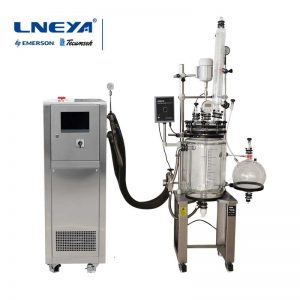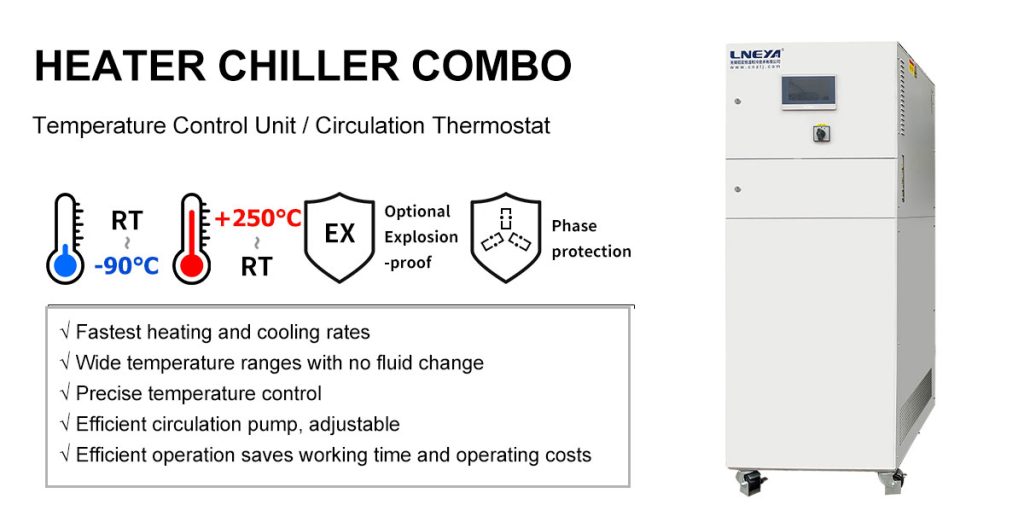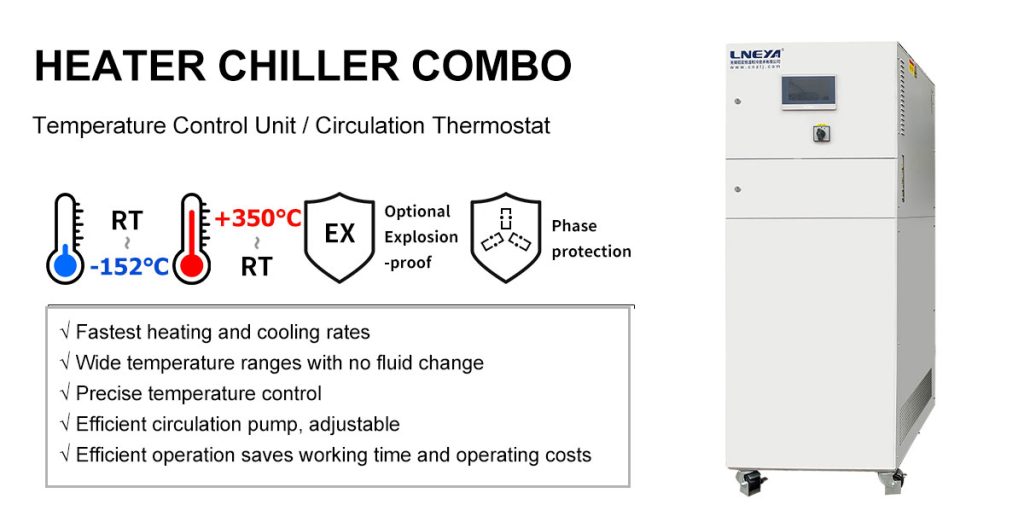Recirculating Chiller For Rotary Evaporator
Choosing the right cooling method for a laboratory rotary evaporator can have an unimaginable impact on the performance, economy and efficiency of the overall system. As a necessary stage of the distillation process, the commonly used condensation methods currently include: using dry ice condensers, equipped with or building a cooling cycle system by yourself, and using tap water for steam cooling. But in most cases, you need to buy recirculating chiller as supporting equipment.
Quando o circulador refrigerado está a funcionar, arrefece o líquido de arrefecimento cheio no depósito de água através do seu sistema de refrigeração e a bomba incorporada bombeia o líquido de arrefecimento para o tubo do condensador para absorver o calor do vapor no condensador e obter o efeito de condensação. O refrigerante com temperatura elevada flui de volta para o tanque de água para arrefecer novamente. Desta forma, o arrefecimento é circulado e trocado para proporcionar uma temperatura de condensação estável para o sistema de evaporação rotativo, evitando efetivamente as flutuações de temperatura sazonais que podem ocorrer quando se utiliza água da torneira. Além disso, a escolha de um refrigerador eficiente e amigo do ambiente para substituir a água da torneira para arrefecimento também ajudará o laboratório a poupar água.
Important factors to consider when choosing the right recirculating chiller include:
Temperatura mínima de condensação e capacidade de arrefecimento correspondente
02. Cycle pressure
03. Circulation flow
04. Suitable accessories
05. Chiller selection guide
Temperatura mínima de condensação e capacidade de arrefecimento correspondente
The minimum temperature of the coolant needs to be below the temperature at which the rotovap condenser will condense the solvent vapor at an optimal rate. This temperature is determined by the boiling point of the solvent. When selecting and setting the temperature of the recirculating chiller, it is generally recommended to follow the “rule of 20”, that is, set a temperature difference of 20°C between the heating pot temperature and the steam temperature, and between the steam temperature and the condenser temperature. For example, set the heating pot temperature to 60°C, adjust the vacuum settings of the system to generate solvent vapor at 40°C, and operate condensation at 20°C. Therefore, the solvent vapor temperature is 20°C lower than the heating pot temperature, and the condenser temperature is 20°C lower than the steam temperature.
The lower the temperature that the recirculating chiller can provide, the better the condensation effect. The recirculating chiller usually has the maximum cooling capacity at 20°C or normal temperature, that is, the maximum cooling power parameter under ideal conditions, which is often the nominal cooling power marked by the manufacturer. For example, our company’s LX recirculating chiller has a cooling capacity of 1000W when the water temperature is 20°C, and the cooling capacity is halved when the water temperature is 5°C, that is, the cooling capacity is about 500W.
As the temperature gets lower, the cooling capacity that the recirculating chiller can achieve decreases. If the recirculating chiller is at the set temperature, the cooling capacity is not enough to take away the heat of the cooling liquid in the distillation, which means that the cooling liquid will not be able to reach the set temperature in the actual distillation, and the ideal condensation efficiency will not be achieved. Therefore, the cooling effect of the recirculating chiller needs to comprehensively consider the two parameters of temperature and cooling capacity.
If the rotary evaporator needs to distill multiple solvents, then the cooling capacity of the recirculating chiller should be selected according to the required minimum condensation temperature. By checking the product specifications, you will find that the recirculating chiller has different cooling capacities corresponding to different temperatures. If the condenser is required to work at a relatively low temperature, it is necessary to have a deep understanding of the cooling capacity of the recirculating chiller at a relatively low temperature, that is, the cooling capacity.
If the recirculating chiller has insufficient power at its set temperature, it means that the cooling liquid will not be able to reach the set temperature during the actual distillation, so that it will not be able to provide enough heat transfer effect to effectively condense the steam. Vapor that cannot be cooled in time will be sucked into the vacuum pump, increasing wear and shortening the service life of pump components, and may even cause irreparable damage. In addition, if your recirculating chiller has an over-temperature alarm function, setting the temperature too low may cause the equipment to alarm and shut down, and the distillation experiment will be interrupted.
02. Cycle pressure
Another important factor to consider is the pressure range of the recirculating chiller’s recirculating pump. The pump pressure for a recirculating chiller is usually in the range of 10-15 psi (0.67-1.03 bar). If the pump pressure is too low, once there is a certain height difference between the rotary evaporator and the refrigerated circulator (for example, the equipment is placed under the test bench), the coolant will not be able to circulate effectively in the condenser. If the pump pressure is too high, the risk of rupture inside the glass condenser due to excessive coolant pressure increases dramatically. The maximum internal pressure of a common glass condenser is 1.5bar, so it is necessary to pay attention to the applicable range of the pressure.
When purchasing a recirculating chiller, it is necessary to confirm the pressure range of the equipment and the working pressure range of the rotary evaporator condenser. In general, most equipment compatible with rotary evaporators has a maximum pump pressure of 11.5 psi (≈0.8 bar), making them suitable for use with glass condensers. If a positive displacement pump and a turbo pump are configured, they often have a higher output pressure, so more attention should be paid to their pump pressure range, so as to avoid the risk of glass condenser rupture due to the use of the corresponding recirculating chiller, or the cooling liquid caused by insufficient pump pressure. Cannot loop effectively.
03. Circulation flow
The pump flow rate of the recirculating chiller affects the residence time of the coolant in the condenser. The lower the flow rate, the longer the coolant stays in the condenser. As the temperature increases, the efficiency of heat transfer between the steam and the coolant decreases. In this case, there is an increased risk of insufficient condensation of solvent vapors.
Although the current flow of most recirculating chillers is sufficient relative to their cooling power, it is still necessary to pay attention to this point.
04. Suitable accessories
Coolant and enhanced cooling water pipeline, according to the temperature range, select the appropriate coolant.
If lower temperatures are required, ethanol or glycol mixtures are recommended. The common coolant is a mixture of ethylene glycol and water containing inhibitors. The working temperature ranges from -30 to +90°C and the ignition point is about 120°C. It is an ideal choice for most recirculating chillers to match the rotary evaporator. Note: Although ethanol does not freeze until 117.3°C, it is highly flammable and presents some risk. Care should be taken when using it as a coolant.
The cooling water line should be selected to match the chemical compatibility of the coolant used, the temperature range of the application, and the pressure rating. Failure to select the correct tubing will result in bursting of the tubing either immediately or over prolonged use. If operating at low temperatures, insulation jackets can be used to reduce heat loss due to ambient temperature effects.
05. Selection guide for recirculating chiller
For different rotary evaporation applications, we provide a variety of recirculating chillers to meet the individual needs of users.
Three basic points:
1. In order to protect the glass condenser, the maximum pump pressure of the cooling circulating water bath shall not exceed 2 bar.
2. In order to obtain the best distillation speed, it is recommended to follow the three-quarters principle: that is, at three-quarters of the height of the condenser and below, the steam should be effectively condensed, form liquid droplets and be discharged as condensate, and try to avoid steam Reaching the upper quarter of the condenser, the steam is sucked by the vacuum pump because it cannot be cooled in time, which affects the performance of the pump.
3. The top of the glass condenser should always maintain an effective low temperature state to avoid steam being sucked into the vacuum pump.
Our company can provide chillers with various temperatures, refrigerating capacity and circulating pressure.
The temperature of the condenser is a key factor affecting the recovery rate, and our recirculating chiller is very suitable for supporting rotary evaporation applications. Low-temperature -20°C, -40°C low-temperature circulating fluid, supplemented by appropriate vacuum control, can effectively recover or evaporate organic solvents.
In the process of continuous distillation of a large amount of volatile solvents under reduced pressure, a suitable low-temperature cooling circulating fluid is generally required.
Soluções personalizadas para o seu negócio
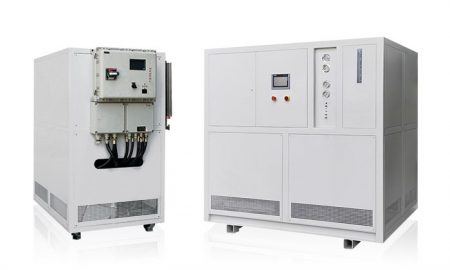
Chillers de baixa temperatura (arrefecidos a água e a ar)
Gama de controlo de temperatura: -150°C a -5°C
Somos especializados na produção de refrigeradores de baixa temperatura com uma gama de controlo de temperatura tão baixa como -150°C, que pode satisfazer as necessidades de refrigeração de diferentes indústrias.
| Gama de temperaturas | Série -25°C ~ -5°C | Série -45°C ~ -10°C | Série -60°C ~ -10°C | Série -80°C ~ -30°C | Série -110°C ~ -50°C |
| Capacidade de arrefecimento | até 360kW | até 360kW | até 360kW | até 270kW | até 180kW |
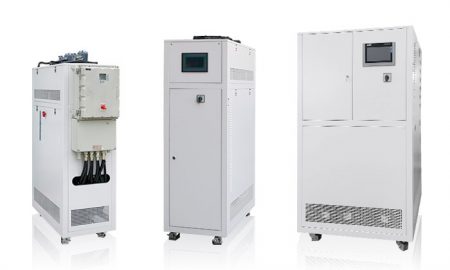
Chillers de recirculação (Arrefecimento a água e ar)
Gama de controlo de temperatura: -120°C a +30°C
Nosso resfriador de recirculação adota tecnologia de refrigeração de baixa temperatura, a temperatura é tão baixa quanto -120 ℃ e vários acessórios são personalizáveis.
| Gama de temperaturas | Série -25°C ~ +30°C | Série -45°C ~ +30°C | Série -60°C ~ -20°C | Série -80°C ~ -20°C | Série -120°C ~ -70°C |
| Capacidade de arrefecimento | até 38kW | até 12kW | até 7,2kW | até 7,2kW | até 8,6kW |
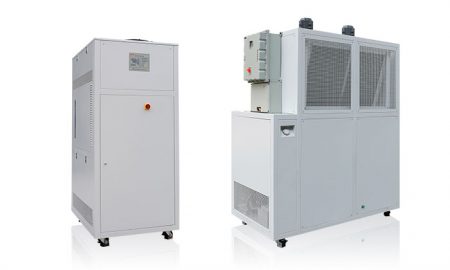
Refrigeradores de temperatura ambiente / Refrigeradores pequenos
Gama de controlo de temperatura: +5°C a +50°C
O refrigerador pode ser amplamente utilizado em várias indústrias e laboratórios, e suporta um design personalizado.
| Gama de temperaturas | -18°C ~ +30°C | Série +5°C ~ +35°C |
| Capacidade de arrefecimento | até 0,9kW | até 50kW |
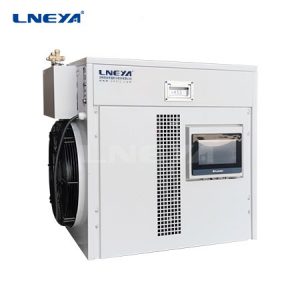
Equipamentos de refrigeração do tipo arrefecimento direto
Gama de controlo de temperatura: -120°C a -10°C
É adequado para locais com pequena área de troca de calor e grande troca de calor.
| Gama de temperaturas | -40°C ~ -10°C | -80°C ~ -35°C | -120°C ~ -90°C |
| Potência do compressor | até 8HP | até 8HP*2 | até 45HP*3 |

Chillers de arrefecimento direto de temperatura ultra baixa
Gama de controlo de temperatura: -150°C a -110°C
Soluções personalizadas para a sua empresa.
| Gama de temperaturas | -150°C ~ -110°C |
| Capacidade de arrefecimento | até 11kW |
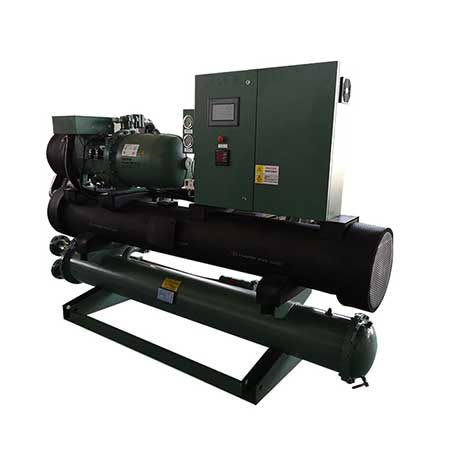
Chillers de parafuso
Refrigeradores de parafuso a baixa temperatura e refrigeradores de parafuso a temperatura ambiente
Soluções personalizadas para a sua empresa.
| Gama de temperaturas | +5°C ~ +30°C | +5°C ~ +30°C | +5°C ~ +30°C | +5°C ~ +30°C | -25°C ~ +5°C | -25°C ~ +5°C |
| Capacidade de arrefecimento | até 1027kW (Compressor único) | até 2134kW (Compressor duplo) | até 934kW (compressor único) | até 1940kW (Compressor duplo) | até 467kW (Compressor único) | até 497kW (Compressor único) |
 LNEYA
LNEYA
 简体中文
简体中文













































































